Spectrometers

|
The earliest picture of a spectrometer I have found
is this cut from Hauksbee and Whiston's Course of Lectures, ca.
1705.
The liquid-filled glass prism was fixed in position,
and the light admitted through the cross-shaped aperture on the left arm.
The eye looks through a sighting tube on the end of the right-hand arm.
Provision is made for slow-motion drive screws at I and K.
|
A. Two-arm Spectrometers
| The basic spectrometer has a light source
S illuminating a slit that acts as an object for lens C. This
produces a parallel beam of light illuminating the prism P. After
refraction by the prism, the light is focussed by lens O on cross-hairs
R. The eyepiece lens E is then used to examine the various
images of the slit in the various colors present in the source. The cut is
from Wm. S. Franklin and Barry MacNutt, Light and Sound (Bethlehem,
PA, 1909) |
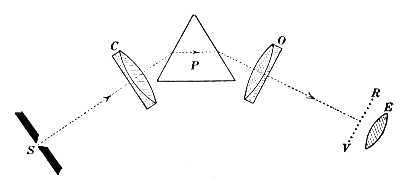
|

|
This large, unmarked spectrometer is at Denison University
in Granville, Ohio. It dates from ca. 1900, and appears to have been equipped
with a holder for a diffraction grating at some later date. Student-type
spectrometers like this one have been in common use since 1900, although
computer-based devices are beginning to take their place. Verniers allow the
angular positions of the arm to be read to the nearest minute or two. |

|
This incomplete spectrometer at Denison is by John
Browning of London. The prism clamp can be clearly seen and the collimating
arm exists, but the telescope has been lost over the years. This is not surprising:
eyepieces and small reading telescopes were useful adjuncts around a physics
department, and were often borrowed. Many physics departments used to have
a small cardboard box filled with eyepieces that had come adrift from their
original apparatus.
This instrument is listed at $38 in the 1888 Queen
Catalogue of Instruments for Physical Optics; the cut clearly shows how the
arms are threaded into their holders.
|
| This small, unmarked spectroscope at Kenyon
College in Gambier, Ohio has lost its eyepiece. The telescope tube can be
adjusted through a small angular range with a tangent screw. |
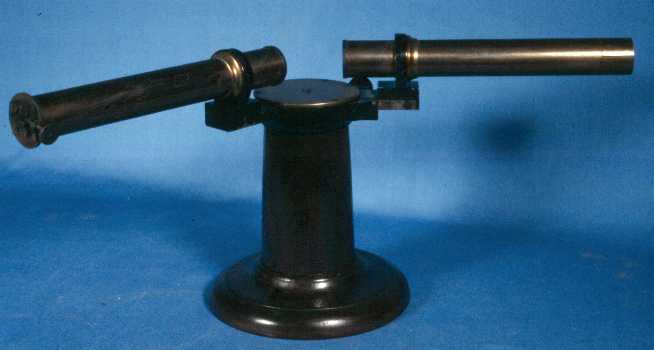
|
The spectrometer below is in the Museum at St. Patrick's College
at Maynooth, County Kildare, Ireland. It was made by Adam Hilger of London,
stands on its own trolley, and the divided circle has a diameter of 45.7
cm. It was used by Walter Hartley (1846-1913) for his research on the spectra
of elements. In 1883 he established that the relationships exist between
the wavelengths in the spectrum of an element and its position in the periodic
table.
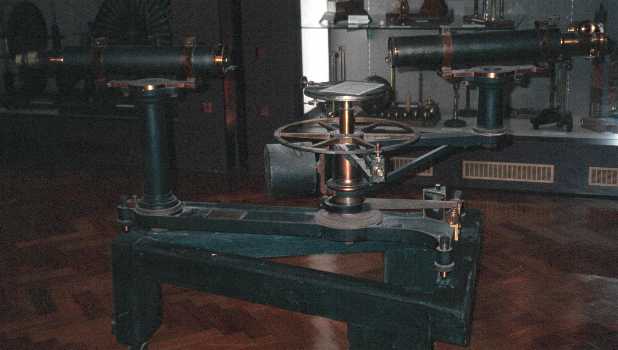
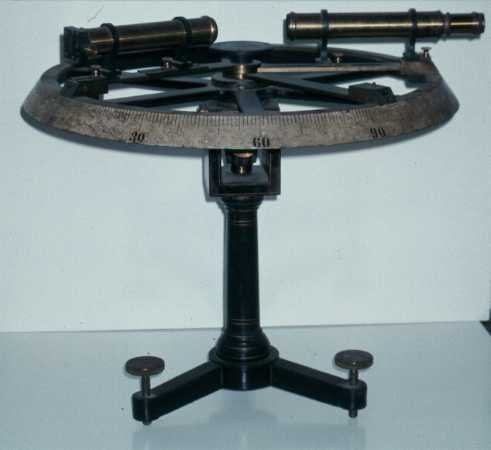
|
This Max Kohl spectroscope at the University of Vermont
rather resembles Jamin's
Divided Circle in its overall form. The 1912 Kohl catalogue that I consulted
at Vermont noted that 'the Goniometer can be used horizontally and vertically.
It is used for more accurate experiments on reflection, refraction and colour-dissipation,
for determining the angles of prisms and refractive indices by Fraunhofer's,
Meyerstein's or Listing-Abbe's Method, as a Goniometer and Spectrum Apparatus.
Height, 50 cm; diameter of circle, 55 cm. The apparatus is graduated
in two degrees." The price was £18, corresponding to about $100. |
| The spectrometer on the right is in the
Birr Science Centre on loan from the Galway physics department.
The spectrometer was made by Max Kohl of Chemnitz,
Germany, and came equipped with a 14438 line per inch diffraction grating
ruled by Rowland of Johns Hopkins University on a blank figured by Brashear.
The apparatus is listed at 725 marks in the Kohl catalogue
published ca. 1900.
|
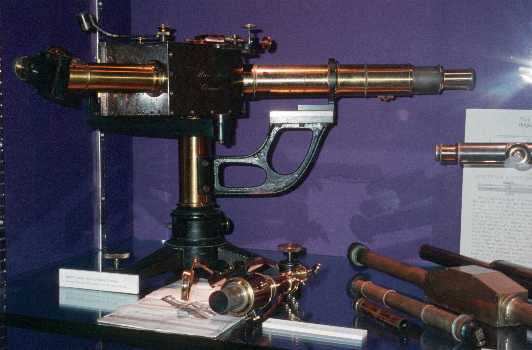
|

|
The two-arm spectrometer at the left is in the apparatus collection
at Hobart and William Smith Colleges in Geneva, New York.
Inside the light-tight cover is a diffraction grating.
It is unmarked, but the style of the feet suggests that it
was made about 1900.
|
B. Three-Arm Spectrometers

|
"To study spectra... physicists employ instruments
called spectroscopes. [The cut at the left] represents one of these. The
flame of a gas lamp is placed in the axis of a lens to which the light penetrates
through a narrow slit; the slit and lens forming what is called the collimator.
The slit being in the focus of the lens, the light passes through the prism
in a parallel beam. The light which passes through the refractive medium
is made to work an image of the slit is made to form an image of the slit
at the focus of another lens, which image is examined by an eyepiece. This
arrangement, which is a great improvement on that adopted by Fraunhofer,
is due to an English optician of great celebrity, Mr. Simms." (From Amédée
Guillemin, The Forces of Nature, Third Edition, trans. by
Mrs. Norman Lockyer (MacMillan and Co., London, 1877), pp 327-328 |
| A present-day user of a spectrometer employs
a diffraction grating; if the grating spacing of the grating is known with
precision the wavelengths may be obtained directly from the angle at which
the particular lines appear.
For most of the nineteenth century the typical spectroscope
used a prism to separate the spectral lines. Calibration was obtained by
projecting the lines of a known spectral source onto the same plane as the
unknown lines.
The diagram at the right, from Franklin and MacNutt,
pg 129, shows how the light from the reference source (at the lower left
of the diagram, is sent into the refracting prism using total internal
reflection from a small prism. To use interpolation to find the unknown
wavelengths, a scale AB, etched on a glass reticule, is reflected
from the surface of the prism and projected on the plane RY of the
images of the known and unknown sources. A divided circle is not necessary
for finding wavelengths.
|
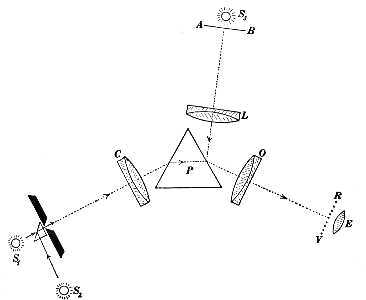
|
| The Queen spectrometer at the right in
in the collection of Kenyon College in Gambier, Ohio. Apart from a small
difference in the top of the column, it appears to be close to Queen's New
Laboratory Spectroscope, listed at $35.00 in the 1888 Queen Catalogue of
Instruments for Physical Optics.
The catalogue notes that "We believe that this spectroscope
supplies a want long felt, and that it will be of great service for student's
use to save larger and finer instruments in the laboratories
of many universities. The extremely low price at which it is furnished brings
it within the reach of all."
|

|
The two spectrometers below are at the University of Vermont.
The one at the right is described in the 1888 Queen Catalogue of Instruments
for Physical Optics as "Bunsen's Laboratory Spectroscope. With One prism.
Consists of a collimator, with adjustable slit and a prism for comparison
of spectra, a second collimator, with a photographed millimeter scale, and
a telescope for examining the rays from the former two. The prism, which
is of flint-glass, is inclosed in a strong metal box. All mounted upon a
neat stand and packed in a strong box with lock ... $55.00"
At the left is a Horizontal Spectroscope by Duboscq, probably
Cat. No. 179 in the 1885 Duboscq catalogue, where it is listed at 300 francs
($60.00). Note the gas-burner for illuminating the scale.

|
The Queen spectrometer at the left is approximately the same
as the one at the right above.
It is at Westminster College in western Pennyslvania. It has suffered the
fate of many older spectrometers and has lost its eyepiece.
|
The unmarked spectrometer at the left, below, is in the collection
of Transylvania University in Lexington, Kentucky. At the right is a Societie
Genovoise spectrometer at Washington and Jefferson College in Washington,
Pennsylvania
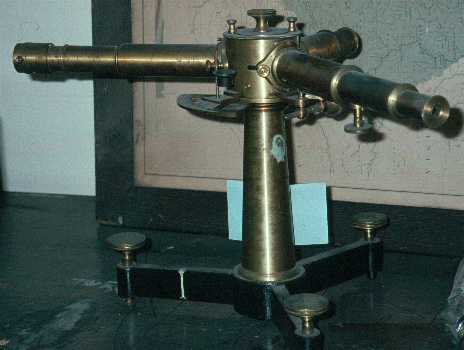
|

|
The spectrometer below was at the Science Centre at Birr Castle
in Birr, County Offaly, Ireland when I photographed it in September 2000.
A year earlier I had seen it at the collection at the physics department
at the National University of Ireland, Galway. It is described as "Instrument
similar to Original Bunsen and Kirchhoff spectroscope -- Mahogany trapezoid
with three brass legs. Housing has hinged lid and both are blackened on
the inside; circular prism table, revolved with brass handle below; brass
tapering cylindrical telescope and collimator; slit adjusted with small knob
-- three holes on housing for reference prism..." in Charles Mollan, Irish
National Inventory of Historic Scientific Instruments (Samton Limited,
Dublin, 1995), pg 362. The third arm, used to project the image of the linear
scale, projects to the rear. A hollow glass prism for holding liquid samples
is to its left.
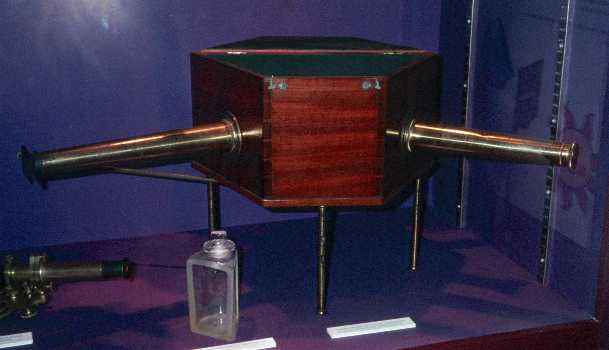
C. One Arm Spectrometers (Direct-Vision Spectrometers)
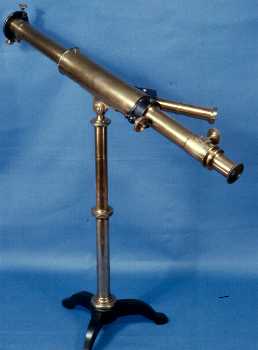
|
| This direct-vision spectrometer at St. Mary's College in Notre Dame,
Indiana, is by John Browning of London.
The cut below, from pg 134 of Franklin and MacNutt,
shows the arrangement of two crown glass and one flint glass equilateral
prisms. This provides zero refraction of the middle part of the prism, but
does give dispersion to produce the spectrum. The images of slit S
are located at RV, the plane on which the eyepiece E is focussed.
There may also a graduated reticule at this point.
The side-arm on the spectroscope at the left
is probably designed to project an image of a reticule on plane RV.
|

|
|
D. Multiple-Prism Spectrometers
| The two-prism spectrometer by John Browning of
London produces twice the dispersion as one using a single prism. The 1888
Queen Catalogue of Instruments for Physics Optics lists this spectrometer
at $78, and notes that the two prisms are of "extra dense glass."
This instrument is in the Garland Collection of Classic
Physics Apparatus at Vanderbilt University, and was probably purchased ca.
1875.
|
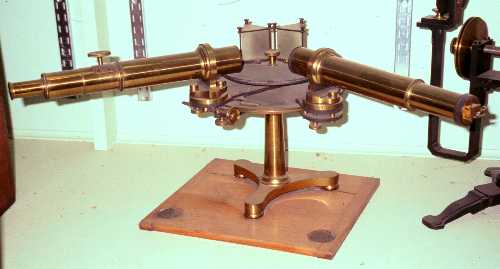
|
D. Wavelength Spectrometers
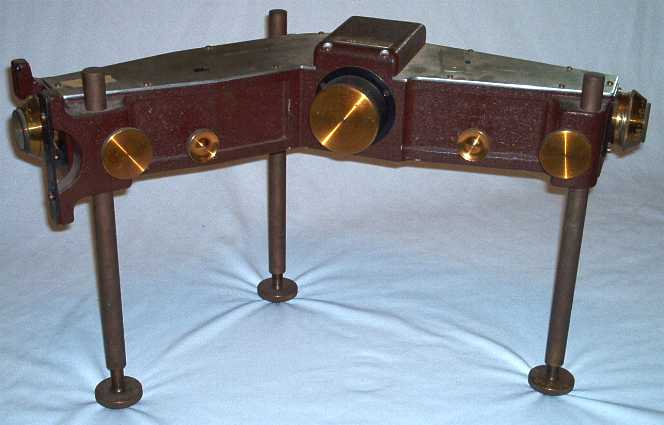
|
The spectrometer at the left is a wavelength spectrometer;
the rotating dial in the middle allows one to dial up a specific wavelength.
Exit and entrance slits are controlled by the rotating rings on the ends
of the instrument. Inside is an equilateral, triangular prism; from the
relatively gentle bend in the case it can be seen that the deviation of
the incoming light is relatively small.
The instrument was made by Billingham and Stanley, Ltd.
of London, and is in the Greenslade Collection.
|
E. Spectrometers for Telescopes
The spectrometer on the left was built
by John A. Brashear of Allegeny, Pennsylvania, for the Smith Observatory
at Hobart College. The date is 1888. The device at the bottom was used to
attach the spectrometer to the telescope: the ring clamped around the telescope
tube and the tubes above and below the collimator arm on the right-hand
side slipped into the two rods on the connector. The spectrometer can also
be used off the telescope.
Brashear (1840-1910) was a self-taught astronometer and instrument
maker who produced, among other projects, the 72 inch mirror for the Dominion
Observatory in Victoria, British Columbia.
|
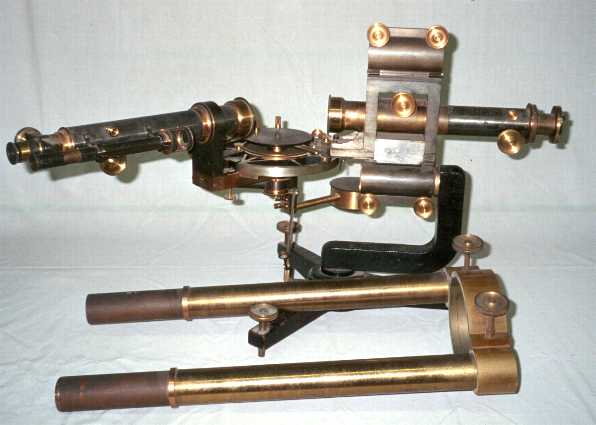
|
Return to Optics Home Page | Return to
Home Page